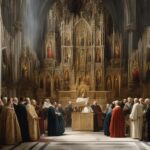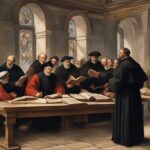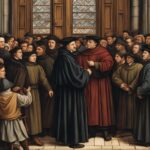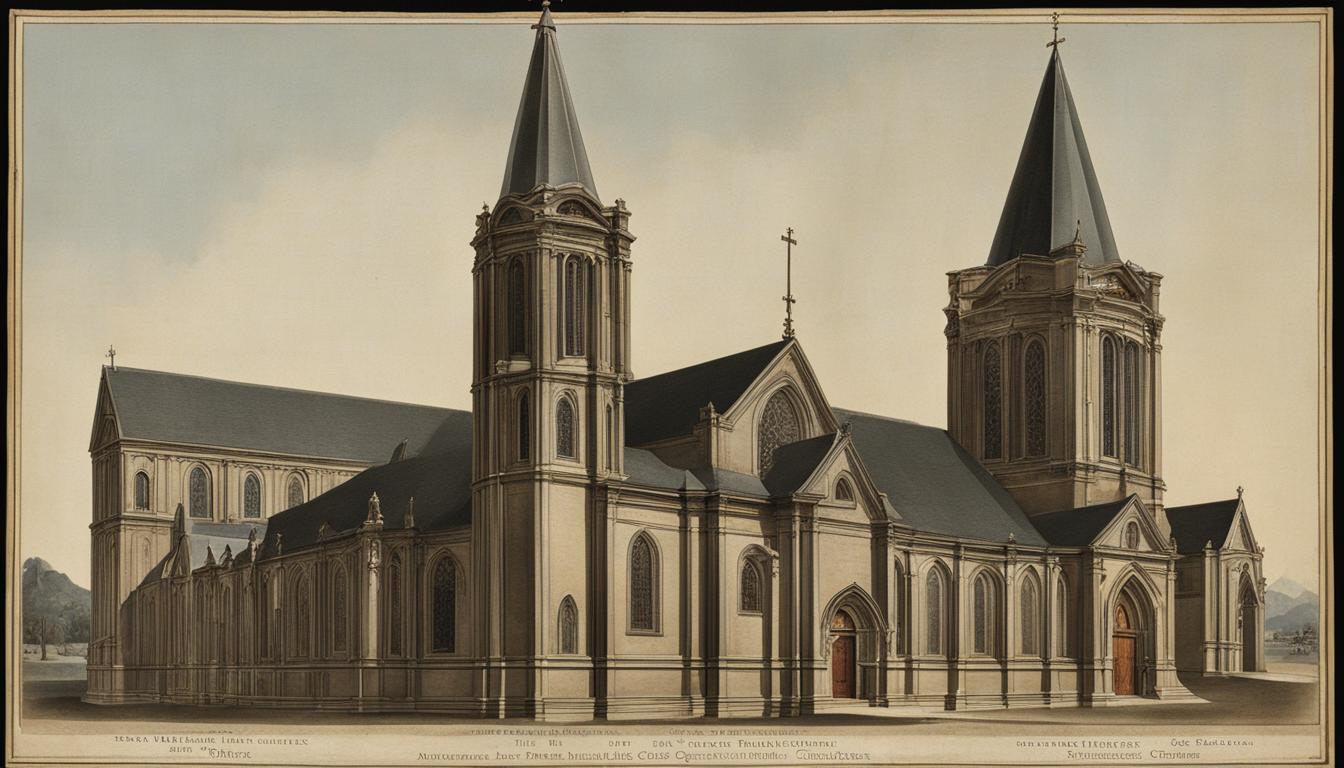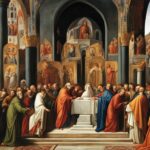The Council of Trent stands as a pivotal event in the rich history of the Catholic Church. Convened by Pope Paul III between 1545 and 1563, it emerged as a response to the growing challenges posed by the Protestant Reformation. This article will delve into the historical background of the Council, its key outcomes, and its lasting effects on the Catholic Church and the wider world. We will also explore the significance of the Council’s decrees and documents, and its role in shaping the Counter Reformation.
Key Takeaways:
- The Council of Trent was a significant ecumenical council of the Roman Catholic Church held between 1545 and 1563.
- It was a response to the challenges posed by the Protestant Reformation and aimed to address the criticisms and abuses within the Catholic Church.
- The Council clarified Catholic doctrine, affirmed the importance of the seven sacraments, and standardized the practice of the Mass.
- Its decisions and decrees played a crucial role in the Counter Reformation and shaped the future of the Catholic Church.
- The Council of Trent remains historically significant and has had a lasting impact on the development of the Catholic faith.
The Council of Trent’s Historical Background
The Protestant Reformation, led by Martin Luther in 1517, ushered in a period of profound religious, political, and social changes in Europe. As various denominations broke away from the Catholic Church, the Church realized the need to address these challenges and reaffirm its doctrines. This led to the convening of the Council of Trent by Pope Paul III between 1545 and 1563.
The primary objectives of the Council of Trent were to clarify Catholic doctrines, address the challenges posed by the Protestant Reformation, and implement necessary reforms within the Church to combat corruption and abuse. At a time when the Catholic Church faced growing criticism and was losing followers to the new Protestant movements, the Council sought to strengthen the Church’s position and reaffirm its authority.
By examining the historical significance of the Council of Trent, we can better understand its objectives and the context in which it took place. This historical background is crucial for comprehending the Council’s decisions, decrees, and lasting impact on the Catholic Church and the wider world.
Protestant Reformation and Catholic Response
The Protestant Reformation, initiated by Martin Luther, challenged the authority and practices of the Catholic Church. Luther’s Ninety-Five Theses, posted in 1517, criticized the Church’s sale of indulgences and called for reform. This sparked a movement that saw the emergence of various Protestant denominations.
In response to the Reformation, the Catholic Church convened the Council of Trent to address the doctrinal disputes and implement reforms. The Council sought to reaffirm Catholic teachings, clarify the role of Tradition and Scripture, and ensure uniformity in liturgical practices.
Objectives of the Council
The Council of Trent had three main objectives:
- Doctrinal Clarification: The Council aimed to clarify Catholic doctrines and teachings to counter the reformist ideas put forth by the Protestant movements. It sought to affirm the Church’s authority and address theological disputes.
- Reform and Discipline: The Council aimed to reform the practices of the Catholic Church, combat corruption, and address issues of moral discipline among the clergy. It sought to improve the education and behavior of the clergy, ensuring they represented the values of the Church.
- Counter-Reformation: The Council played a crucial role in the Counter-Reformation, a movement aimed at revitalizing the Catholic Church and countering the spread of Protestantism. It sought to strengthen Catholic identity, attract followers back to the Church, and address the criticisms and abuses that triggered the Protestant Reformation.
The Council of Trent’s historical background provides essential context for understanding the motivations and objectives behind this significant event in the history of the Catholic Church. It sheds light on the religious, political, and social changes of the time and helps us grasp the Council’s lasting impact.
Important Facts about the Council of Trent
The Council of Trent, also known as the 19th Ecumenical Council, was a significant event in the history of the Catholic Church. Spanning three sessions over almost two decades, the Council took place in the Northern Italian city of Trent. It brought together bishops, theologians, and other Church officials from across Europe to address the challenges posed by the Protestant Reformation and implement reforms within the Church.
The participants of the Council of Trent gathered to discuss and make binding decisions on a wide range of topics, including doctrine, discipline, and the structure of the Church. The Council’s decrees were considered binding for all Catholics and played a crucial role in shaping the Counter-Reformation or Catholic Reformation. Its influence extended far beyond the walls of Trent, reaching the practices and beliefs of the Catholic Church at large.
The Council of Trent was a response to the religious, political, and social changes brought about by the Protestant Reformation. It aimed to reaffirm Catholic doctrines, clarify and standardize the practice of the sacraments, address issues of corruption and abuse within the Church, and strengthen the authority of the Catholic Church in the face of Protestant challenges. The Council’s decisions and decrees had a lasting impact on the Catholic Church and played a significant role in shaping the course of Western Christianity.

| Key Facts about the Council of Trent | |
|---|---|
| Event | 19th Ecumenical Council |
| Number of Sessions | Three |
| Location | Northern Italian city of Trent |
| Participants | Bishops, theologians, and Church officials from across Europe |
| Decisions | Considered binding for all Catholics |
| Significance | Played a crucial role in shaping the Counter-Reformation |
Major Figures and Their Contributions
The Council of Trent was marked by the participation of several influential figures who played crucial roles in shaping its outcomes and contributions to the Catholic Church. Let’s take a closer look at some of these key figures and their significant contributions:
Pope Paul III
Pope Paul III was the driving force behind the Council of Trent. He recognized the need for reforms within the Catholic Church and took the initiative to convene the Council. His leadership and support set the stage for the Council’s deliberations and the subsequent implementation of its decrees.
Cardinal Giovanni Morone
Cardinal Giovanni Morone played a vital role in the Council of Trent as a diplomatic figure. He facilitated dialogue between different factions within the Council, helping to navigate contentious issues and reach consensus. His diplomatic skills were instrumental in finding common ground among the participants.
Cardinal Charles Borromeo
Cardinal Charles Borromeo was another key participant in the Council of Trent. He not only played a significant role in the Council’s discussions but also took on the responsibility of implementing its decrees in the Archdiocese of Milan. His efforts contributed to the practical implementation of the Council’s reforms in a local context.
St. Ignatius of Loyola
St. Ignatius of Loyola, the founder of the Jesuit Order, had a profound impact on the Counter-Reformation. Although he did not attend the Council of Trent, his founding of the Society of Jesus (Jesuits) and their subsequent involvement in missionary work, education, and intellectual pursuits played a crucial role in advancing the Council’s goals and the revitalization of the Catholic Church.
In summary, the Council of Trent benefited from the contributions of prominent figures such as Pope Paul III, Cardinal Giovanni Morone, Cardinal Charles Borromeo, and St. Ignatius of Loyola. Each of these individuals played a vital role in initiating, shaping, and implementing the Council’s decrees, advancing the goals of the Catholic Church during a pivotal time in its history.
Key Outcomes of the Council of Trent
The Council of Trent resulted in significant reforms within the Catholic Church, impacting various aspects of its doctrine and practices. These outcomes played a crucial role in shaping the Counter-Reformation and solidifying the Catholic faith. Here are some of the key outcomes of the Council:
Reforms to the Catholic Church
One of the primary aims of the Council of Trent was to address the criticisms and abuses that had fueled the Protestant Reformation. To combat these challenges, the Council introduced reforms aimed at combating corruption and ensuring the integrity of the Catholic Church. These reforms included stricter guidelines for clerical education, regulations on the sale of indulgences, and measures against clerical corruption. By implementing these reforms, the Council sought to restore faith in the Catholic Church and strengthen its authority.
Clarity on Catholic Doctrine
The Council of Trent played a crucial role in clarifying Catholic doctrine and defining the core beliefs of the Church. The Council affirmed the necessity of the seven sacraments, including baptism, confirmation, and the Eucharist. It emphasized the importance of the Mass as the central act of Catholic worship and established guidelines for its uniform practice, known as the Tridentine Mass. These clarifications on doctrine helped solidify the Catholic faith and provided a clear foundation for Catholic teachings.
Regulation of Canonizations
The Council of Trent also addressed the process of canonization, which involves declaring individuals as saints within the Catholic Church. It established guidelines for the canonization process, ensuring that it was conducted with rigor and integrity. These regulations helped to prevent abuses and ensure that the canonization of saints was based on careful examination and evidence of holiness. By regulating canonizations, the Council aimed to maintain the sanctity and integrity of the process within the Catholic Church.
| Outcome | Description |
|---|---|
| Catholic Church Reforms | Stricter guidelines for clerical education, regulations on the sale of indulgences, measures against clerical corruption |
| Clarity on Catholic Doctrine | Affirmation of the seven sacraments, guidelines for the Tridentine Mass |
| Regulation of Canonizations | Establishment of guidelines for the canonization process |
These key outcomes of the Council of Trent had a lasting impact on the Catholic Church and helped shape its practices and beliefs. The reforms implemented by the Council sought to address the challenges posed by the Protestant Reformation and strengthen the Catholic Church’s position in the Counter-Reformation. The Council’s decisions on doctrine, reforms, and regulations continue to influence the Catholic faith to this day.
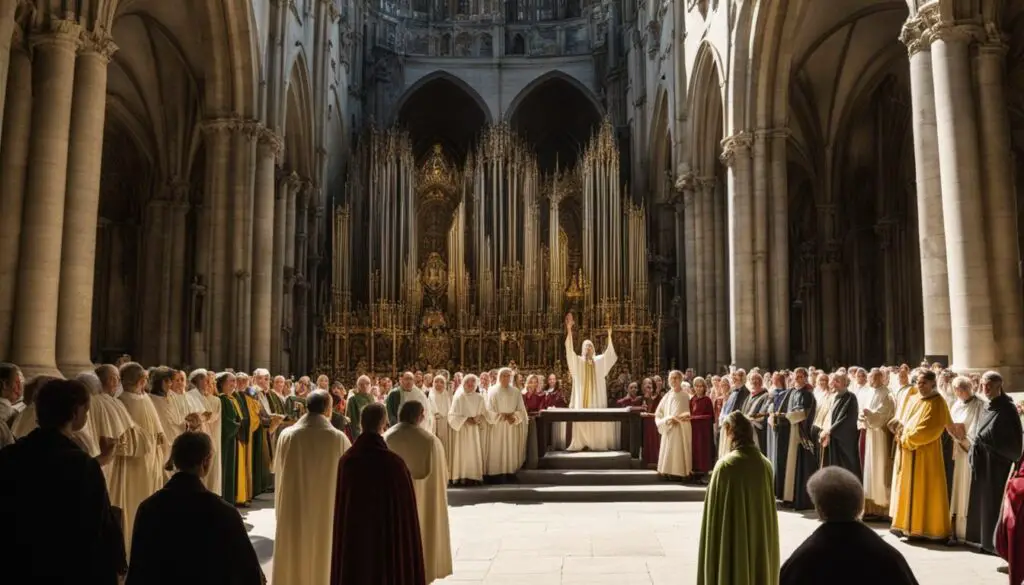
Reforms to the Church and Council of Trent Indulgences
One of the central issues addressed by the Council of Trent was the reform of indulgences and the clarification of their role in the Catholic Church. Indulgences had become a source of controversy and abuse, with some individuals exploiting the practice for financial gain. This abuse, along with other grievances, played a significant role in triggering the Protestant Reformation led by Martin Luther.
The Council of Trent responded to these concerns by enacting reforms to ensure the proper understanding and use of indulgences. It prohibited the sale of indulgences, making it clear that they were not a commodity to be bought or sold. The Council also established guidelines for pastoral practices regarding indulgences, emphasizing their spiritual purpose and the need for sincere repentance.
“By prohibiting the sale of indulgences and addressing the abuses associated with them, the Council of Trent sought to reaffirm the spiritual nature of indulgences and restore their rightful place within Catholic doctrine.”
These reforms not only addressed the immediate grievances surrounding indulgences but also contributed to the broader reforms of the Catholic Church during the Counter-Reformation. By tackling the issue of indulgences head-on, the Council of Trent aimed to restore faith and trust in the Church and prevent further defections to Protestantism.
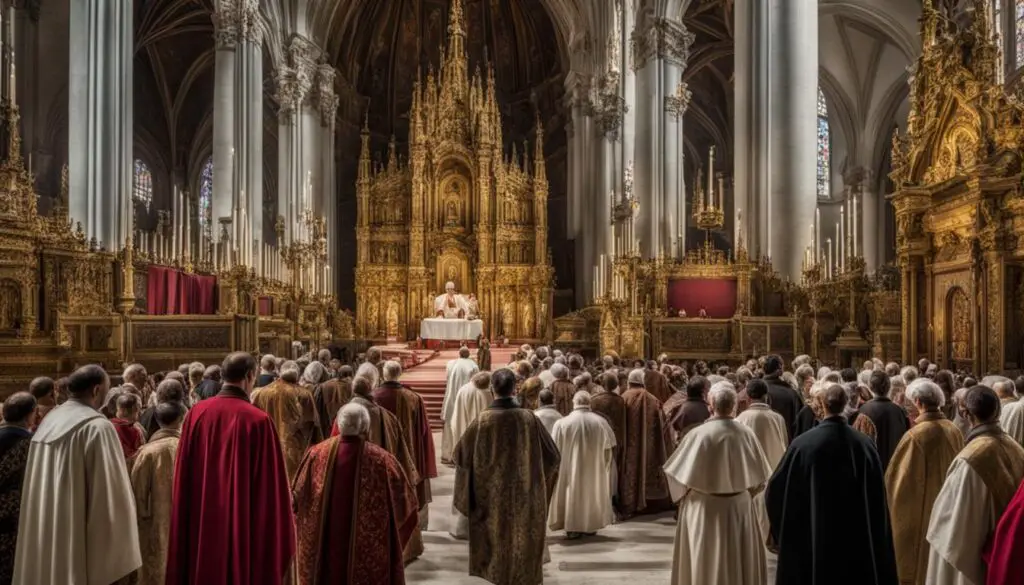
The Impact of the Council’s Reforms
The reforms enacted by the Council of Trent regarding indulgences were part of a larger movement to address the grievances raised by the Protestant Reformation. These reforms, which included measures to combat corruption and improve the education of clergy, played a vital role in restoring the credibility and authority of the Catholic Church. The Council’s actions were instrumental in reestablishing the Church’s central role in the lives of its followers and reaffirming its teachings.
Furthermore, the reforms to indulgences demonstrated the Church’s willingness to self-reflect and adapt to the changing times. By acknowledging and rectifying the abuses associated with indulgences, the Council of Trent showed a commitment to the spiritual well-being of its members and a desire to address the concerns of the faithful.
| Key Reforms to Indulgences | Impact |
|---|---|
| Prohibition of the sale of indulgences | Restored the spiritual nature of indulgences and prevented financial exploitation |
| Guidelines for pastoral practices | Emphasized the importance of sincere repentance and clarified the purpose of indulgences |
The Council of Trent’s reforms to indulgences were a significant step in the overall process of revitalizing the Catholic Church and addressing the issues that led to the Protestant Reformation. By tackling the abuse of indulgences and reaffirming their spiritual significance, the Council’s actions helped to restore faith in the Catholic Church and solidify its place as a guiding force in the lives of its followers.
Impact on Catholic Doctrine and Practices
The Council of Trent had a significant impact on Catholic doctrine and practices, shaping the beliefs and traditions of the Catholic Church. One of the key areas addressed by the Council was the relationship between Scripture and Tradition. The Council affirmed the importance of both sources of authority, emphasizing that they were interdependent and should be interpreted in harmony.
Another important aspect of the Council’s impact was on the sacraments. The Council clarified the seven sacraments of the Catholic Church and reaffirmed their significance in the spiritual life of believers. It emphasized the role of the sacraments in imparting divine grace and the necessity of participating in them for salvation.
The Council also standardized the practice of the Mass. It introduced the Tridentine Mass, which became the standard liturgy of the Catholic Church for centuries. This standardized form of worship ensured consistency and unity in the celebration of the Eucharist across the Catholic world.
In addition, the Council of Trent established guidelines for clerical education, aiming to raise the quality of the clergy and address issues of corruption. It emphasized the importance of proper training and formation for priests and bishops, ensuring that they were equipped to fulfill their pastoral duties effectively.
Furthermore, the Council regulated the practice of canonizations, which are the official declarations of sainthood in the Catholic Church. It established rigorous standards and procedures to ensure that only deserving individuals were recognized as saints, safeguarding the integrity of the canonization process.
Through its decrees and reforms, the Council of Trent sought to eradicate corruption within the Catholic Church and solidify its teachings and practices. Its influence can still be felt in the present day, as the foundations laid by the Council continue to shape Catholic doctrine and guide the spiritual lives of millions of believers worldwide.
The External Impacts of the Council of Trent
The Council of Trent had a profound impact not only on the Catholic Church but also on the wider European religious and political landscape. It marked the beginning of the Counter-Reformation, a movement aimed at revitalizing the Catholic Church and countering the spread of Protestantism. As a result, numerous religious orders were established, playing a crucial role in the resurgence of Catholicism and the spread of its teachings.
One notable example is the Society of Jesus, also known as the Jesuits. Founded by St. Ignatius of Loyola, the Jesuits became instrumental in the Counter-Reformation by promoting Catholic values and education. They focused on establishing schools, colleges, and universities, ensuring the propagation of Catholic doctrine and the training of future clergy and missionaries.
| Impact | Description |
|---|---|
| Baroque Art and Architecture | The Council of Trent’s emphasis on the visual splendor of the Catholic faith influenced the development of the Baroque style. Churches and religious buildings were adorned with elaborate decorations, grandiose architecture, and dramatic artworks, aiming to inspire awe and reverence in the faithful. |
| International Politics | The Council of Trent played a significant role in international politics during the time of the European religious conflicts. It bolstered the authority and influence of the Catholic Church, solidifying the power of the Papacy and shaping alliances between Catholic rulers. The decisions made during the Council also had diplomatic implications, impacting the relationships between Catholic and Protestant nations. |
| Church Authority | The Council of Trent reaffirmed and strengthened the authority of the Catholic Church, particularly in matters of doctrine and religious practices. Its decrees established a clear hierarchy within the Church and centralized decision-making power, ensuring the unity and stability of the Catholic faith. |
The external impacts of the Council of Trent were far-reaching and continue to shape the Catholic Church and its influence in the modern world. From the artistic legacy of the Baroque era to the political dynamics of international relations, the Council’s decisions and reforms left an indelible mark on the religious and cultural landscape of Europe.

Discovering the Council of Trent Location
The Council of Trent, one of the most important events in the history of the Catholic Church, took place in the northern Italian city of Trent, now known as Trento. This picturesque city, nestled in the foothills of the Italian Alps, served as the venue where bishops, theologians, and Church officials gathered to discuss and make decisions that would shape the future of the Catholic faith. The historical significance of Trent as the location of the Council cannot be understated, as it marked a crucial turning point in the Catholic Church’s response to the challenges of the Protestant Reformation.

The choice of Trent as the site for the Council was strategic. Located in a region known for its strong Catholic presence, Trent provided a neutral ground for the participants, far from the political turbulence of the time. The city’s favorable geographical position, with its accessibility and central location in Europe, made it an ideal meeting place for delegates from across the continent. The Council’s sessions took place in the majestic Cathedral of Trent, a symbol of Trento’s rich religious heritage.
Today, visitors to Trent can explore the historical landmarks associated with the Council of Trent. The Trento Cathedral, where the sessions were held, still stands as a testament to the Church’s commitment to addressing the challenges of the time. The city’s museums and archives house a wealth of information on the Council, providing invaluable insights into this significant event in Catholic history. As visitors wander through the streets of Trent, they are reminded of the Council’s lasting impact on the Catholic Church and its role in shaping the religious and political landscape of Europe.
Conclusion
The Council of Trent was a pivotal event in the history of the Catholic Church. Convened between 1545 and 1563, in response to the challenges posed by the Protestant Reformation, the Council aimed to clarify Catholic doctrines and implement necessary reforms within the Church. Its significance cannot be overstated.
The Council’s key outcomes had a lasting impact on the Catholic Church and the wider world. It brought about crucial reforms, such as the clarification of Catholic doctrine, the affirmation of the seven sacraments, the standardization of the Mass, and the regulation of canonizations. These measures played a vital role in the Counter-Reformation and shaped the practices and beliefs of the Catholic Church.
Externally, the Council of Trent influenced the religious and political landscape of Europe. It led to the establishment of the Counter-Reformation, a movement aimed at revitalizing the Catholic Church and countering Protestantism. The Council’s decisions also had an impact on the arts, particularly the development of Baroque style, and reinforced the Church’s authority in international politics.
In summary, the Council of Trent remains significant in the history and development of the Catholic faith. Its lasting impact can be seen in the reforms it implemented, as well as its influence on the Counter-Reformation and the wider European religious and political landscape. The Council of Trent stands as a testament to the Catholic Church’s resilience and adaptability in the face of significant challenges.
FAQ
What is the Council of Trent?
The Council of Trent was a pivotal event in the history of the Catholic Church. It was a response to the challenges posed by the Protestant Reformation and aimed to clarify Catholic doctrines, address the challenges of the Reformation, and implement necessary reforms within the Church.
When did the Council of Trent take place?
The Council of Trent was convened by Pope Paul III between 1545 and 1563.
Where did the Council of Trent take place?
The Council of Trent took place in the Northern Italian city of Trent (now known as Trento).
Who were the participants of the Council of Trent?
The Council of Trent brought together bishops, theologians, and other Church officials from across Europe.
What were the key outcomes of the Council of Trent?
The Council of Trent brought about reforms within the Catholic Church, clarified Catholic doctrines, standardized the practice of the Mass, established guidelines for clerical education, and regulated the practice of canonizations.
What was the role of the Council of Trent in the Counter-Reformation?
The Council of Trent played a crucial role in shaping the Counter-Reformation or Catholic Reformation, which was a movement aimed at revitalizing the Catholic Church and countering the spread of Protestantism.
What was the impact of the Council of Trent on Catholic doctrine and practices?
The Council of Trent clarified the role of Scripture and Tradition in Church teachings, affirmed the necessity of the seven sacraments, standardized the practice of the Mass with the adoption of the Tridentine Mass, established guidelines for clerical education, regulated the practice of canonizations, and enforced measures against clerical corruption.
How did the Council of Trent influence the wider European religious and political landscape?
The Council of Trent led to the establishment of the Counter-Reformation, influenced the creation of religious orders such as the Jesuits, and had an impact on the arts, particularly the Baroque style. Its decisions also played a role in international politics and reinforced the Church’s authority.
What is the historical significance of Trent?
Trent holds historical significance as the venue for the Council of Trent, an important event in the history of the Catholic Church. It served as the setting where bishops, theologians, and Church officials gathered to discuss and make decisions that would shape the future of the Catholic faith.
What is the lasting impact of the Council of Trent?
The Council of Trent had a lasting impact on the Catholic Church and the wider world. Its decisions and decrees shaped the Counter-Reformation, solidified Catholic teachings and practices, and influenced the religious and political landscape of Europe.

